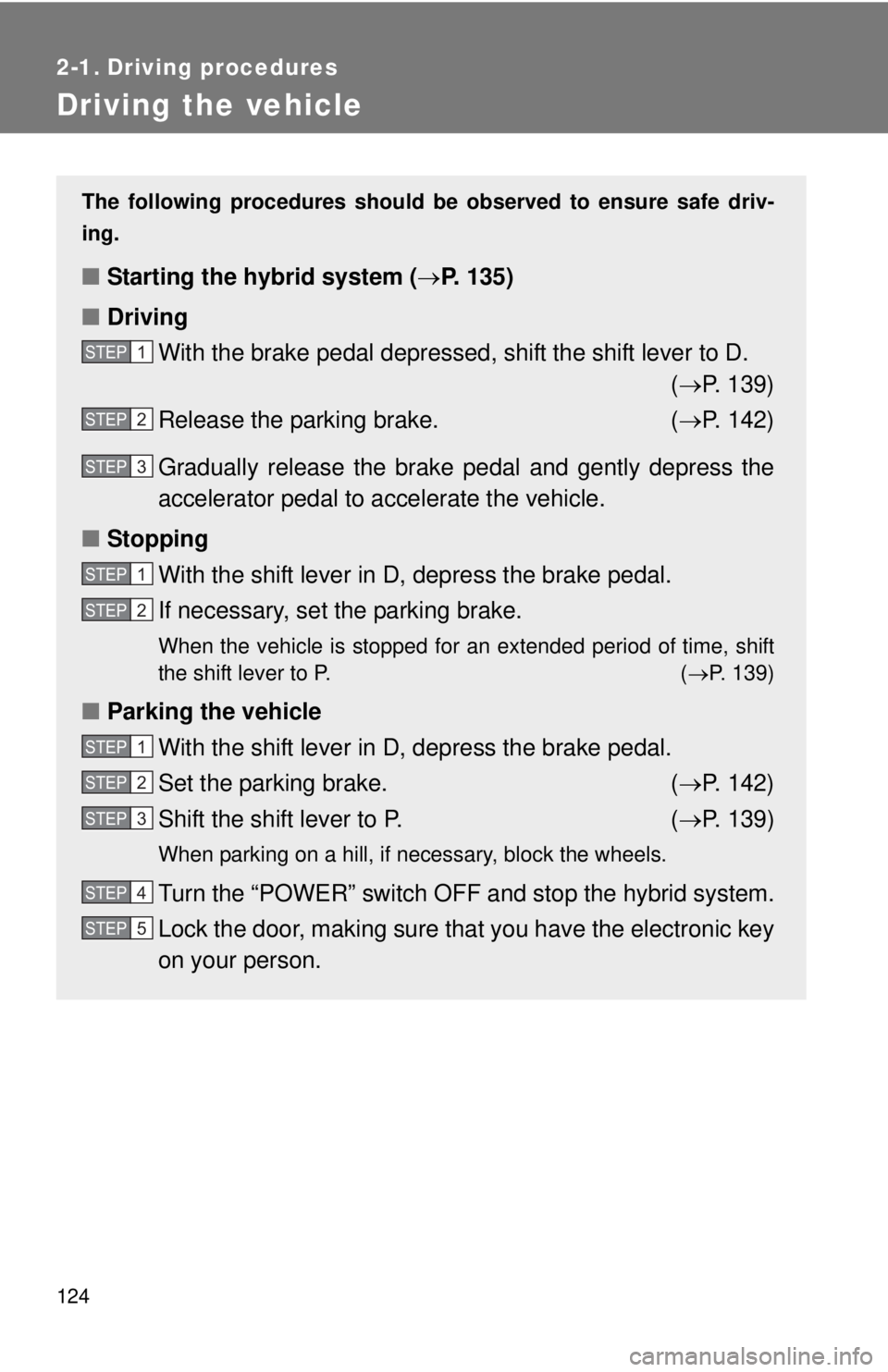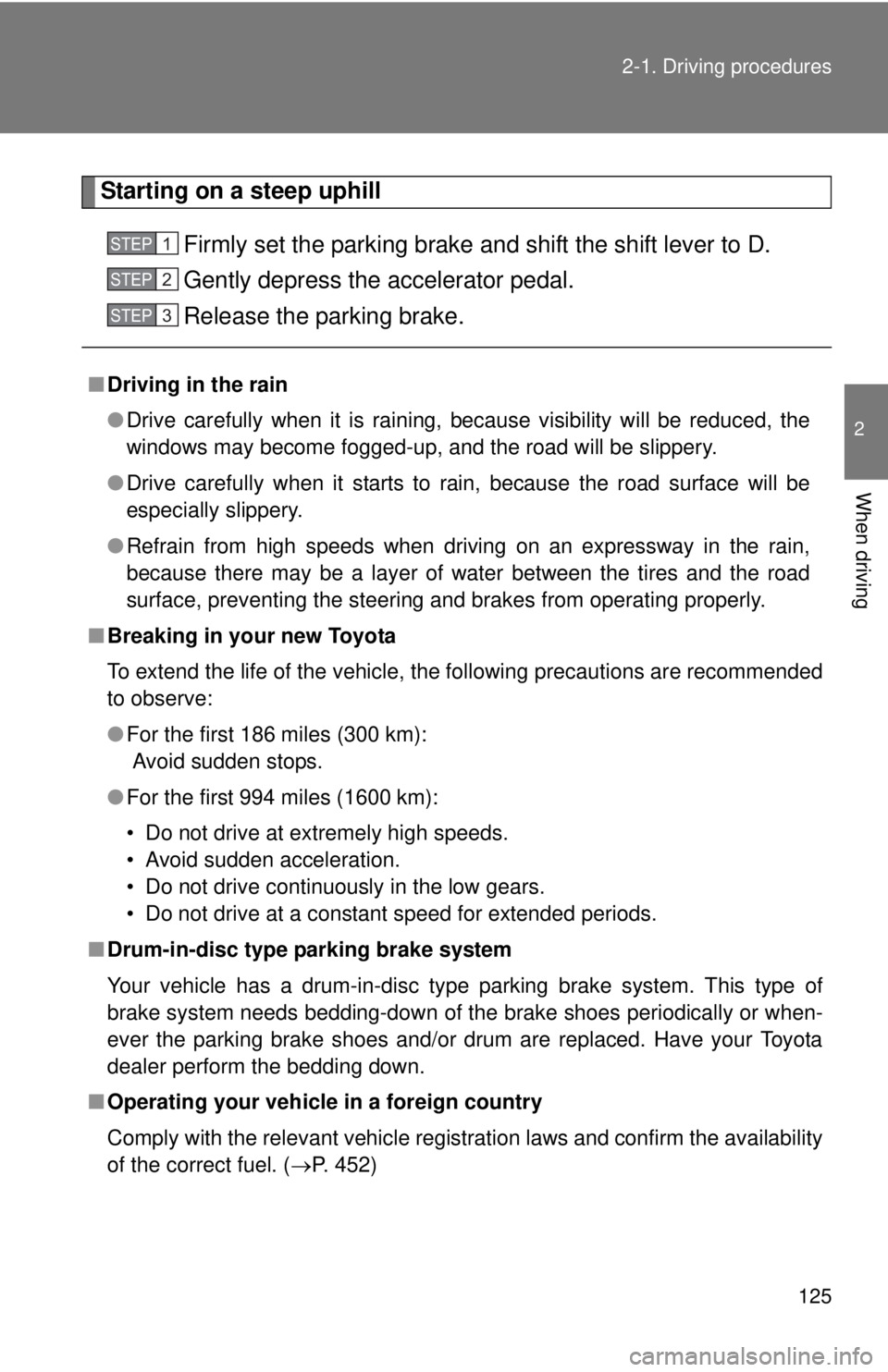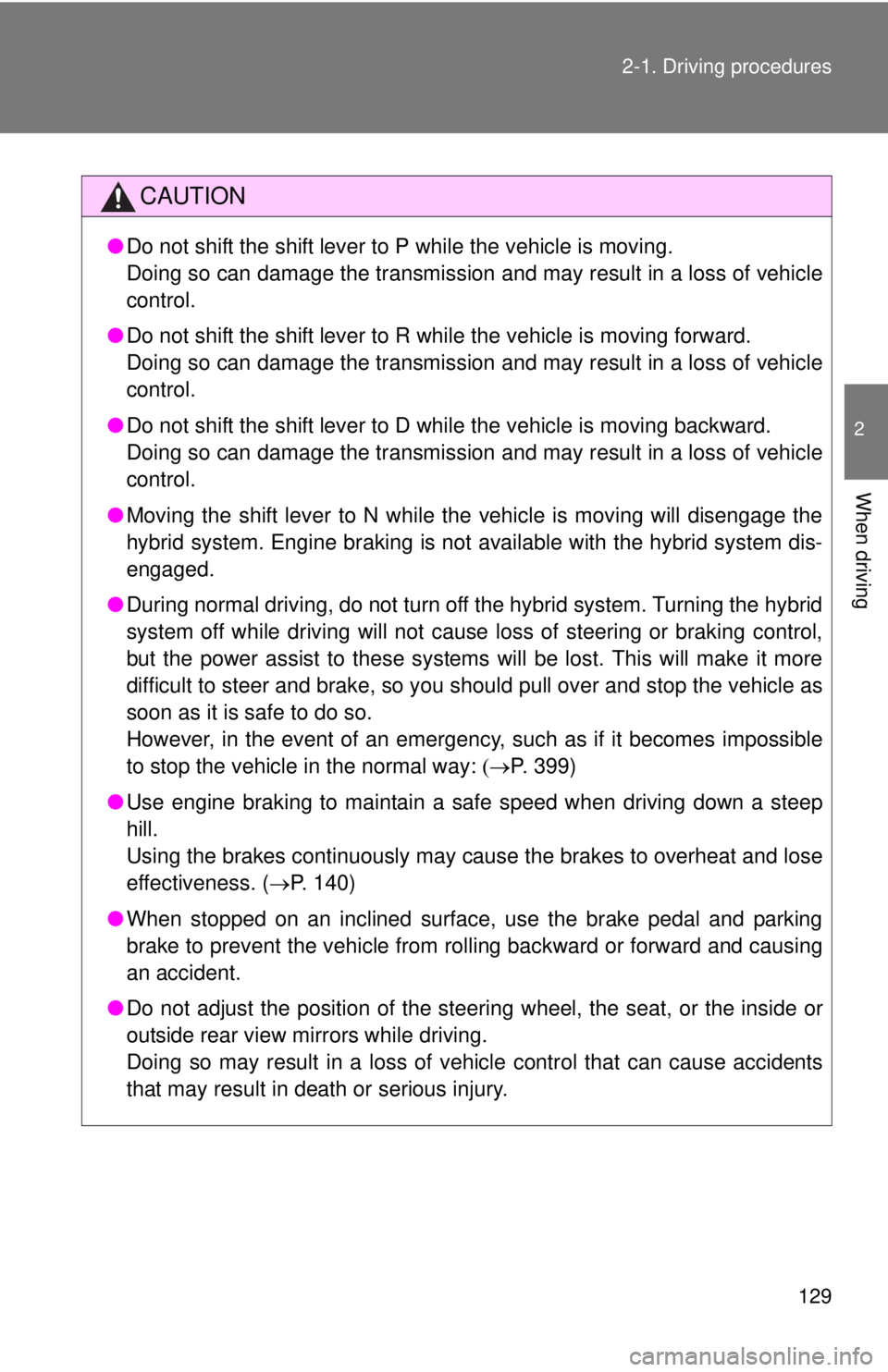2011 TOYOTA CAMRY HV parking brake
[x] Cancel search: parking brakePage 2 of 508

TABLE OF CONTENTSIndex
2
1-1. Hybrid systemHybrid system ...................... 22
1-2. Key information Keys ..................................... 35
1-3. Opening, closing and locking the doors
Smart key system................. 37
Wireless remote control ....... 48
Doors.................................... 51
Trunk .................................... 55
1-4. Adjustable components (seats, mirrors,
steering wheel)
Front seats ........................... 59
Rear seats ............................ 61
Head restraints ..................... 62
Seat belts ............................. 64
Steering wheel ..................... 72
Anti-glare inside rear view mirror .................................. 73
Outside rear view mirrors ..... 75
1-5. Opening and closing the windows
Power windows .................... 77
Moon roof ............................. 79
1-6. Refueling Opening the fuel tank cap .... 83 1-7. Theft deterrent system
Immobilizer system ............... 88
1-8. Safety information Correct driving posture ......... 90
SRS airbags ......................... 92
Front passenger occupant classification system ......... 104
Child restraint systems ....... 109
Installing child restraints ..... 113
2-1. Driving procedures Driving the vehicle .............. 124
Power (ignition) switch........ 135
Transmission ...................... 139
Turn signal lever ................. 141
Parking brake ..................... 142
Horn .................................... 143
2-2. Instrument cluster Gauges and meters ............ 144
Indicators and warning lights ................................. 147
Multi-information display ..... 150
2-3. Operating the lights and wipers
Headlight switch ................. 154
Fog light switch ................... 158
Windshield wipers and washer .............................. 159
1Before driving
2When driving
Page 12 of 508

12
Gauges and meters
Multi-information display P. 144
P. 150
Tilt and telescopic steering control lever
P. 72Hood lock releaselever
P. 338
Pictorial index
Fuel filler door opener
P. 83
Headlight switch
Turn signal lever
Fog light switch
P. 154
P. 141
P. 158
Instrument panel
Audio system
Navigation system *1
P. 192
Windshield wiper and
washer switch
P. 159
Clock
Security indicator P. 303
P. 88Outside rear view
mirror switches
P. 75
Tire pressure warning reset switch
P. 355
Auxiliary box P. 298
Parking brake pedal P. 142
Trunk opener P. 55
“ECO HEAT/COOL” switch
P. 182
Emergency flashers P. 392
Shift lock override button
P. 431
Horn
P. 143
Page 24 of 508

24 1-1. Hybrid system
●To help prevent the 12-volt battery from becoming discharged, drive the
vehicle at least once a month, and operate the accessories only when
the “READY” indicator is on. When parking the vehicle, make sure the
doors and trunk are closed and all lights are turned off.
■ After the 12-volt battery has di scharged or has been changed or
removed
The gasoline engine may not stop even if the vehicle is running on the hybrid
battery (traction battery). If this continues for a few days, contact your Toyota
dealer.
■ Sounds and vibrations specific to a hybrid vehicle
There may be no engine sounds or vibration even though the vehicle is able
to move. Always put the shift lever in P when parked.
The following sounds or vibrations may occur when the hybrid system is
operating, and are not a malfunction:
●Motor sounds may be heard from the engine compartment.
● Sounds may be heard from the hybrid battery (traction battery) behind
the rear seat when the hybrid system starts or stops.
● Sounds may be heard from the transaxle when the hybrid system starts
or stops, or while the vehicle is idling.
● Engine sounds may be heard when accelerating sharply.
● Sounds may be heard due to the regenerative braking when you press
the brake pedal.
● Vibration may be felt when the gasoline engine starts or stops.
● Cooling fan sounds may be heard from the air intake vents behind the
rear seat.
■ Maintenance, repair, recycling, and disposal
Contact your Toyota dealer regarding maintenance, repair, recycling and dis-
posal. Do not dispose of the vehicle yourself.
Page 33 of 508

33
1-1. Hybrid system
1
Before driving
CAUTION
■
Road accident cautions
Observe the following precautions to reduce the risk of injury.
●Pull your vehicle off the road, put the shift lever in P, apply the parking
brake, and turn the hybrid system off.
● Do not touch the high voltage parts, cables and connectors.
● If electric wires are exposed inside or outside your vehicle, an electric
shock may occur. Never touch exposed electric wires.
● If a fluid leak occurs, do not touch it as it may be strong alkaline electrolyte
from the hybrid battery (traction battery). If it comes into contact with your
skin or eyes, wash it off immediately with a large amount of water or if pos-
sible, boric acid solution. Seek immediate medical attention.
● If a fire occurs in the hybrid vehicle, leave the vehicle as soon as possible.
Never use a fire extinguisher that is not meant for electric fires. Using even
a small amount of water may be dangerous.
● If your vehicle needs to be towed, do so with the front wheels raised. If the
wheels with the electric motor (traction motor) are on the ground when
towing, the motor may continue to generate electricity. This may cause an
electricity leakage leading to a fire. (
P. 393)
■ Nickel-metal hydride battery
Your vehicle contains a sealed nickel-metal hydride battery. If disposed of
improperly, it is hazardous to the environment and there is a risk of severe
burns and electrical shock that may result in death or serious injury.
■ If the system activates
●Carefully check to see if there are exposed high voltage parts or cables.
Never touch the parts or cables. (
P. 25)
● Carefully inspect the ground under the vehicle. If you find that liquid has
leaked onto the ground, the fuel system may have been damaged. Leave
the vehicle as soon as possible.
Page 123 of 508

When driving2
123
2-1. Driving proceduresDriving the vehicle............ 124
Power (ignition) switch ..... 135
Transmission.................... 139
Turn signal lever .............. 141
Parking brake ................... 142
Horn ................................. 143
2-2. Instrument cluster Gauges and meters ......... 144
Indicators and warning lights .............................. 147
Multi-information display............................ 150
2-3. Operating the lights and wipers
Headlight switch ............... 154
Fog light switch ................ 158
Windshield wipers and washer ........................... 159
2-4. Using other driving systems
Cruise control ................... 161
Driving assist systems ..... 165
2-5. Driving information Cargo and luggage .......... 169
Vehicle load limits ............ 172
Winter driving tips ............ 173
Trailer towing ................... 177
Dinghy towing .................. 178
Page 124 of 508

124
2-1. Driving procedures
Driving the vehicle
The following procedures should be observed to ensure safe driv-
ing.
■ Starting the hybrid system ( P. 135)
■ Driving
With the brake pedal depressed, shift the shift lever to D. ( P. 139)
Release the parking brake. ( P. 142)
Gradually release the brake pedal and gently depress the
accelerator pedal to accelerate the vehicle.
■ Stopping
With the shift lever in D, depress the brake pedal.
If necessary, set the parking brake.
When the vehicle is stopped for an extended period of time, shift
the shift lever to P. ( P. 139)
■Parking the vehicle
With the shift lever in D, depress the brake pedal.
Set the parking brake. ( P. 142)
Shift the shift lever to P. ( P. 139)
When parking on a hill, if necessary, block the wheels.
Turn the “POWER” switch OFF and stop the hybrid system.
Lock the door, making sure that you have the electronic key
on your person.
STEP1
STEP2
STEP3
STEP1
STEP2
STEP1
STEP2
STEP3
STEP4
STEP5
Page 125 of 508

125
2-1. Driving procedures
2
When driving
Starting on a steep uphill
Firmly set the parking brake and shift the shift lever to D.
Gently depress the accelerator pedal.
Release the parking brake.
■Driving in the rain
●Drive carefully when it is raining, because visibility will be reduced, the
windows may become fogged-up, and the road will be slippery.
● Drive carefully when it starts to rain, because the road surface will be
especially slippery.
● Refrain from high speeds when driving on an expressway in the rain,
because there may be a layer of water between the tires and the road
surface, preventing the steering and brakes from operating properly.
■ Breaking in your new Toyota
To extend the life of the vehicle, the following precautions are recommended
to observe:
●For the first 186 miles (300 km):
Avoid sudden stops.
● For the first 994 miles (1600 km):
• Do not drive at extremely high speeds.
• Avoid sudden acceleration.
• Do not drive continuously in the low gears.
• Do not drive at a constant speed for extended periods.
■ Drum-in-disc type parking brake system
Your vehicle has a drum-in-disc type parking brake system. This type of
brake system needs bedding-down of the brake shoes periodically or when-
ever the parking brake shoes and/or drum are replaced. Have your Toyota
dealer perform the bedding down.
■ Operating your vehicle in a foreign country
Comply with the relevant vehicle registration laws and confirm the availability
of the correct fuel. ( P. 452)
STEP1
STEP2
STEP3
Page 129 of 508

129
2-1. Driving procedures
2
When driving
CAUTION
●
Do not shift the shift lever to P while the vehicle is moving.
Doing so can damage the transmission and may result in a loss of vehicle\
control.
● Do not shift the shift lever to R while the vehicle is moving forward.
Doing so can damage the transmission and may result in a loss of vehicle\
control.
● Do not shift the shift lever to D while the vehicle is moving backward.
Doing so can damage the transmission and may result in a loss of vehicle\
control.
● Moving the shift lever to N while the vehicle is moving will disengage the
hybrid system. Engine braking is not available with the hybrid system dis-
engaged.
● During normal driving, do not turn off the hybrid system. Turning the hybrid
system off while driving will not cause loss of steering or braking control,
but the power assist to these systems will be lost. This will make it more
difficult to steer and brake, so you should pull over and stop the vehicle as
soon as it is safe to do so.
However, in the event of an emergency, such as if it becomes impossible
to stop the vehicle in the normal way: P. 399)
● Use engine braking to maintain a safe speed when driving down a steep
hill.
Using the brakes continuously may cause the brakes to overheat and lose
effectiveness. ( P. 140)
● When stopped on an inclined surface, use the brake pedal and parking
brake to prevent the vehicle from rolling backward or forward and causing
an accident.
● Do not adjust the position of the steering wheel, the seat, or the inside or
outside rear view mirrors while driving.
Doing so may result in a loss of vehicle control that can cause accidents
that may result in death or serious injury.